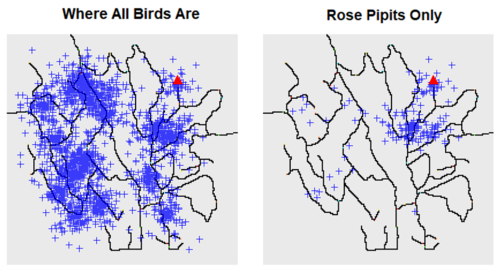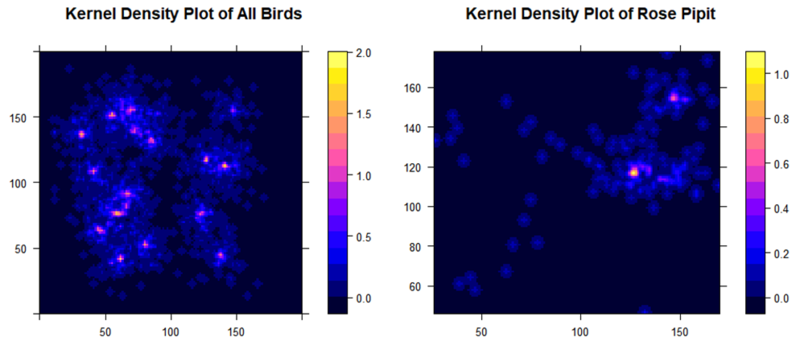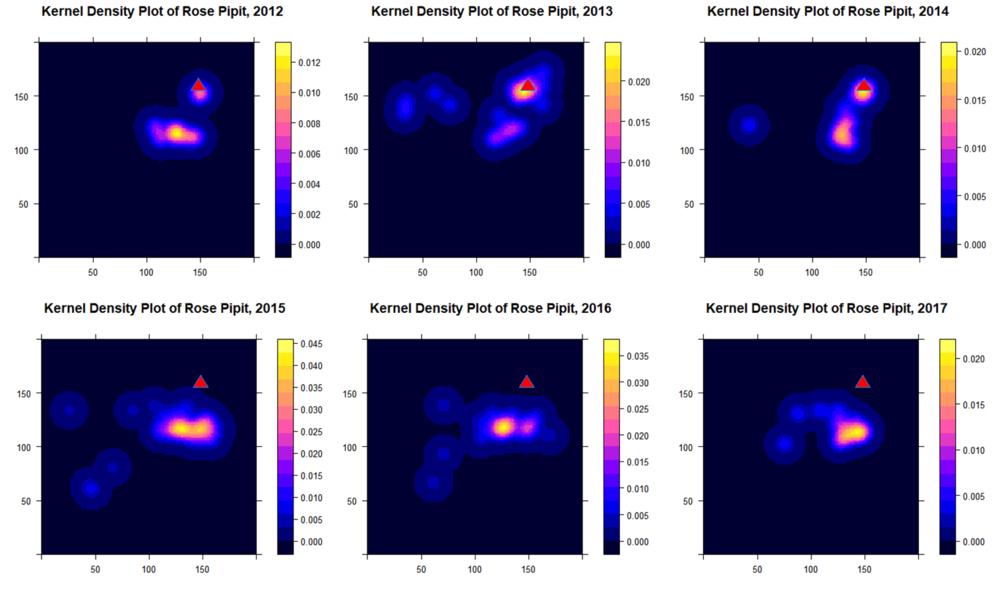Difference between revisions of "ISSS608 2017-18 T3 Assign Chan En Ying Grace Did Rose Pipit kick the bucket"
| Line 86: | Line 86: | ||
[[File:Pic5.png|800px]] | [[File:Pic5.png|800px]] | ||
| + | |||
| + | <hr/> | ||
===7. Kernel Density Plot of Rose Pipits Across Time (2012-2017)=== | ===7. Kernel Density Plot of Rose Pipits Across Time (2012-2017)=== | ||
Revision as of 23:20, 22 June 2018
|
|
|
|
|
|
Contents
- 1 Cluster Visualisation: "Did Rose Pipit actually kicketh the bucket?"
- 1.1 1. Data Overview
- 1.2 2. Clustering by Species
- 1.3 3. Assignment of Treatment & Control Groups
- 1.4 4. Rose Pipits Only – Across the 4 Seasons
- 1.5 5. Rose Pipits Across Time
- 1.6 6. Kernel Density Plot to visualize clusters (All Birds & Rose Pipit)
- 1.7 7. Kernel Density Plot of Rose Pipits Across Time (2012-2017)
Cluster Visualisation: "Did Rose Pipit actually kicketh the bucket?"
1. Data Overview
Different bird species were found throughout the preserve, but Pipits were found typically in the northeastern side of the preserve – that is, closest to the alleged Dumping Site marked by the triangle below.
We can also see a visible Pipit cluster near/at the Dumping Site. This is likely why the alleged dumping by Kasios was “accused” to cause the death of the Pipits since the Pipits were found at that location.
2. Clustering by Species
To characterize the pattern relative to the alleged dumping site (blue triangle), the following facet plot shows the clustering patterns by Bird Species, independent of time.
From the cluster locations, we can see that the Rose-Crested Blue Pipits are clustered around the alleged dumping site, explaining why the 15 test birds provided are claimed to be Rose-Crested Blue Pipits to prove the allegation wrong. We can use this facet plot to have a good overview of other bird species’ cluster locations, such as the Ordinary Snape and Lesser Birchbeere being also clustered near to the Dumping Site.
3. Assignment of Treatment & Control Groups
If the dumping indeed took place, one would expect that other birds in this dumping area would also decrease in population as they would migrate elsewhere or die from the dumping substance, not just affecting the Rose Pipits.
Other species that are dominantly clustered around the dumping site include the Ordinary Snape and Lesser Birchbeere. These populations should also be affected by the dumping, if dumping indeed happened. We will thus use Ordinary Snape (OS) and Lesser Birchbeere (LB) as our Control Group, and Rose-Crested Blue Pipits (Rose Pipit) as our Treatment Group.
4. Rose Pipits Only – Across the 4 Seasons
Just like other bird species, Rose Pipits population peaked in the Spring. When we analyse its population across time, we should bear in mind that seasonal or monthly population changes would not help us determine the true population patterns accurately as change in population is likely due to seasonal migration, than dumping. Thus, we will track its population changes across Year, than across month or season.
5. Rose Pipits Across Time
There are two observations here.
a. First, the Pipit population increased in 2013 to 2017.
In 2013, the cluster appeared right at the alleged dumping site. We call this the Pipit home range, where the Pipits tended to live and thrive. Population soared in 2015 and then declined gradually till 2017.
However, it is important to note that this is a short 5-year period and prior to 2013, Pipits were few and far between. One possible interpretation could be that Pipits only found the Boonseng Preserve as their home in 2013, and lived elsewhere prior to this.
Another possible interpretation could be due to data quality issue. Although it is mentioned that the data is well represented, an overview of the data showed signs of data quality, especially in the earlier years (80s, 90s) where birds across all species were reported to be very few. Due to the incompleteness of data, we will focus on years 2013-2017 for a more reliable study.
b. Second, the home range moved away from the dumping site, from 2015 onwards even though that was the year of peak.
This could be signs of dumping. It could be that the dumping caused Pipits to fly slightly further away, but the long-run effect was that the birds population dwindled as they struggled to survive given the decline in population size (as the cluster got smaller). It could be that only those that flew away from the site survived.
But given that the Kasios company provided some Pipit bird calls, we should also analyse to see if it really belongs to Pipits, and whether these calls were obtained around the dumping site or far away from it. If far away, then it could support the dumping claim. If near, then more work needs to be put in to analyse this.
6. Kernel Density Plot to visualize clusters (All Birds & Rose Pipit)
To visualize the above clusters more clearly, we plot the Kernel Density to visualize the size and intensity.
If we look at Rose Pipits (right), the Kernel Density plot gives us clearer visualization that there were 2 (not 1!) clusters formed. This could possibly indicate some sort of migration from one to the other. As the bottom cluster (away from dumping site) looks bigger than the top cluster (at dumping site), it could also be a sign of dumping, as dumping chemicals could cause the population to be smaller and give rise to the Pipits' migration from its original homerange to a new homerange.
To verify this, let us do a Kernel Density plot for Pipits across time for a six-year period from 2012-2017.
7. Kernel Density Plot of Rose Pipits Across Time (2012-2017)
Interestingly, when we plot the the Kernel Density across time, we can see that there were two clusters in 2012 – one at the dumping site, and one slightly away from the dumping site. The cluster at the dumping site grew in size until 2014, while the cluster away from the dumping site took over and started to grow in 2014.
More importantly, the cluster at the dumping site vanished totally from 2015 onwards, leaving only the cluster away from the dumping site, which grew in size. This could indicate a movement of birds from the dumping site cluster towards the cluster away from the dumping site, possibly indicating a trend of dumping.






